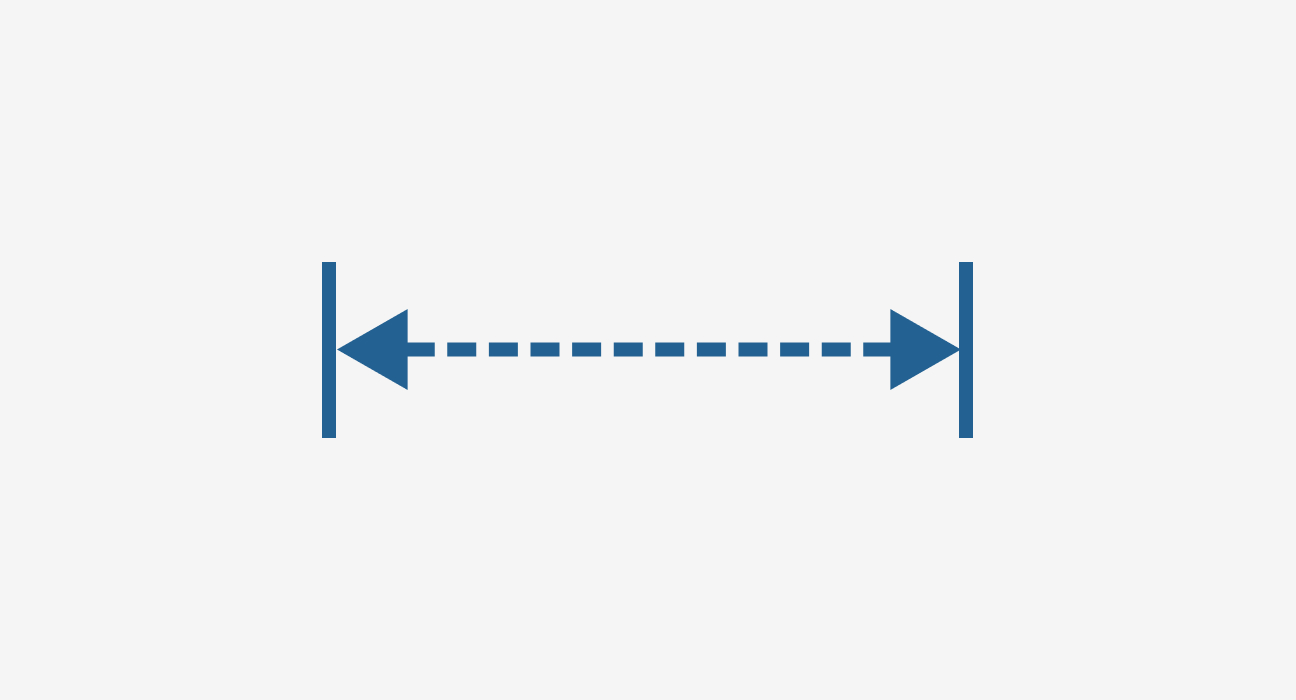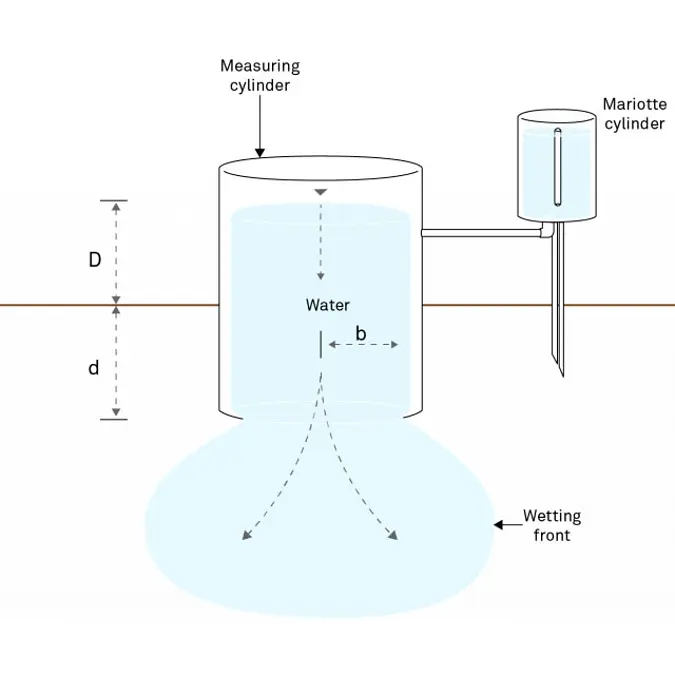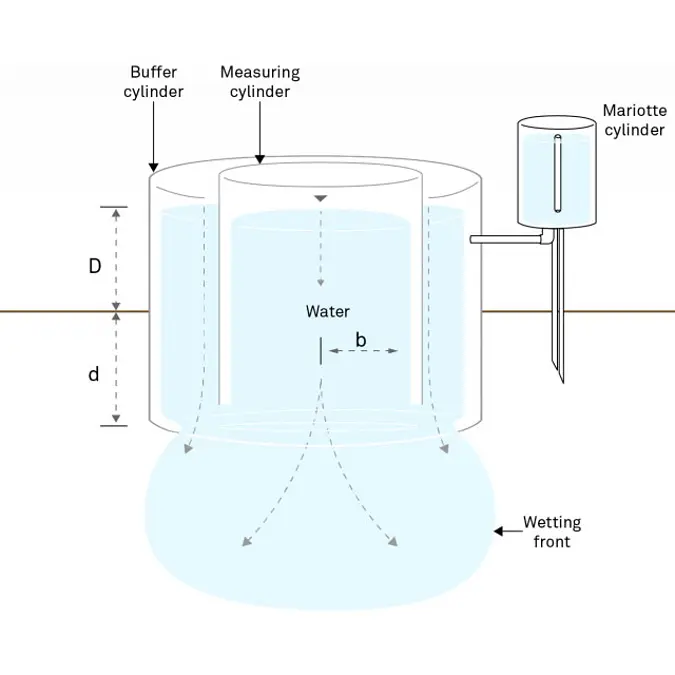Hydraulic conductivity: How many measurements do you need?
Researchers are changing the way infiltration measurements are captured while keeping the standards of measurement high.

Saturated hydraulic conductivity, or the ability of soil to absorb water, has traditionally been a complex measurement for scientists to make. Inaccurate field saturated hydraulic conductivity (Kfs) measurements are common due to errors in soil-specific alpha estimation and inadequate three-dimensional flow buffering. Three-dimensional flow means water infiltrates the soil in three dimensions; it spreads laterally, as well as downward. The problem is, the value which represents saturated hydraulic conductivity, Kfs, is a one-dimensional value. Researchers use Kfs in modeling as the basis of their decision making, but to get that value, they must first remove the effects of three-dimensional flow.
The traditional method for removing the effects of three-dimensional flow is to look at a table of alpha values or the soil macroscopic capillary length. But since alpha is only an estimate of the sorptivity effect, or how much the soil is going to pull the water laterally, the risk of inaccuracy is high. And if a researcher or engineer chooses the wrong alpha value, their estimate could be significantly off.
To get around this problem, researchers sometimes measure Kfs with a double-ring infiltrometer (Figure 2), a simple method where the outer ring is intended to limit the lateral spread of water after infiltration and buffer three-dimensional flow. However, a double-ring infiltrometer does not buffer three-dimensional flow perfectly (Swartzendruber D. and T.C. Olson 1961a). So if researchers operate on the assumption that they’re getting one-dimensional flow in the center ring, they may overestimate their field saturated conductivity values. This can be disastrous, particularly when working with a soil that has been engineered to have a very low permeability. If Kfs is overestimated, a researcher or engineer could incorrectly assume a landfill cover (for example) is ineffective (Ks is over 10-5 cm s-1), when in reality, they’ve overestimated Kfs, and the cover is actually compliant.
The SATURO eliminates the estimation/assumption problem by automating the well-established dual head method. It ponds water on top of the soil and uses air pressure to create two different pressure heads. Measuring infiltration at these two different pressure heads avoids the need for estimating the alpha factor, enabling researchers to determine field saturated hydraulic conductivity without making any assumptions. Additionally, the SATURO uses much less water because it doesn’t require a large outer ring like a double ring infiltrometer. This automated approach saves time and reduces error in the hydraulic conductivity assessment. The following theory section explains in detail why this is possible.
See how SATURO readings compare with double-ring infiltrometer readings
In the video below, Dr. Gaylon S. Campbell teaches the basics of hydrology and the science behind the SATURO automated dual head infiltrometer. In this 30-minute webinar learn:
Field saturated hydraulic conductivity, Kfs (cm/s) is a fundamental soil hydraulic property that describes the ease with which a fluid (usually water) can move through pore spaces or fractures under field saturated conditions. One of the oldest and simplest methods for in situ determination of Kfs has involved the measurement of ponded infiltration (D) from within a single ring (with a radius b) pushed a small distance into the soil (d) (Figure 1). The original analysis used the measured steady flow rate, Qs (cm3/s) and assumed one-dimensional, vertical flow to obtain Kfs from Bouwer (1986) and Daniel (1989).

This approach overestimated Kfs due to lateral divergence of flow resulting from the capillarity of the unsaturated soil and from the ponding in the ring (Bouwer 1986). Attempts to eliminate flow divergence involved the addition of an outer ring to buffer the flow in the inner ring (Figure 2). However, the double-ring infiltrometer technique was ineffective at preventing lateral flow from the inner ring (Swartzendruber and Olson 1961a, 1961b).

More recent research provides new methods for correcting for lateral flow. Reynolds and Elrick (1990) presented a new analysis method of steady ponded infiltration into a single ring, which accounts for soil capillarity, depth of ponding, ring radius (b), and depth of ring insertion (d) and provides a means for calculating Kfs, matric flux (φm), and macroscopic capillary length (∝). This analysis is known as the two-ponding head approach (Reynolds and Elrick 1990).
The two-ponding head approach is the technique used by SATURO, though with some modifications and simplifications. The simplest equation for this calculation is from Nimmo et al. (2009). They compute Kfs as shown in Equation 1.

where i (cm/s) is the steady (final) infiltration rate (volume divided by area) and F is a function that corrects for sorptivity and geometrical effects.
Nimmo et al. (2009) gives F as shown in Equation 2

where
In Equation 2, ∆ is simply Equation 36 of Reynolds and Elrick (1990) multiplied by bπ, which allows Figure 2 and Equation 2 to be reconciled with Equation 37 of Reynolds and Elrick (1990).
For two ponding depths, use Equation 3:

Rearranging one of the right terms to solve for λ in terms of Kfs, substituting this for λ in the other right term, and simplifying yields

where
For ∆, d is the infiltrometer insertion depth and b is the infiltrometer radius. For the SATURO, 5-cm insertion ring, d = 5 cm and b = 7.5 cm, so ∆ = 9.3 cm. For the 10-cm insertion ring, d = 10 cm and b = 7.5 cm, so ∆ = 14.3 cm.
The hydraulic conductivity is then multiplied by the difference in quasi-steady state infiltration rate for the last pressure cycle and divided by the difference in the measured pressure head from the last pressure cycle.
Equation 4 is equivalent to Equation 41 from Reynolds and Elrick (1990) and removes the dependence on soil characteristics and initial water content described by λ.
The SATURO combines automation and simplified data analysis together in one system. It even computes infiltration rates and field saturated hydraulic conductivity on the fly. The SATURO makes life a little easier for those who need a faster, more accurate way to measure Kfs in the field.
Our scientists have decades of experience helping researchers and growers measure the soil-plant-atmosphere continuum.
Six short videos teach you everything you need to know about soil water content and soil water potential—and why you should measure them together. Plus, master the basics of soil hydraulic conductivity.
Researchers are changing the way infiltration measurements are captured while keeping the standards of measurement high.
If your data are skewed in the wrong direction, your predictions will be off, and erroneous recommendations or decisions could end up costing you. Leo Rivera discusses common mistakes and best practices.
Leo Rivera, research scientist at METER, teaches which situations require saturated or unsaturated hydraulic conductivity and the pros and cons of common methods.

Receive the latest content on a regular basis.